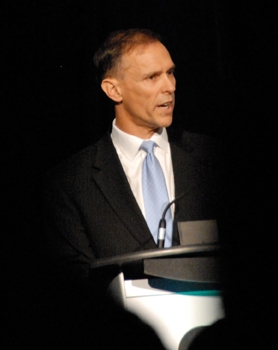
Industry News
Markets
Events & Education
’Twas the Season
It was conference season in the Pacific Northwest this spring as a number of forest industry delegates hit Portland, Ore., Seattle, Wash. and Vancouver, B.C. for presentations on everything from the state of the industry to the technical side of wood composites. One prominent topic at all of the events was biomass, and what role it can play in the forest industry, both today and in the future.
December 1, 2011 By Trina Dillon
 Craig Campbell It was conference season in the Pacific Northwest this spring as a number of forest industry delegates hit Portland
Craig Campbell It was conference season in the Pacific Northwest this spring as a number of forest industry delegates hit Portland
Wood Composites Symposium
At the 43rd International Wood Composites Symposium in Seattle at the end of March, some speakers introduced the positives of biomass and bioenergy into their presentations. However keynote speaker Wolf-Gerd Dieffenbacher, president and CEO of the German wood panel press system manufacturer Dieffenbacher, told the audience of about 150 industry, government and academic research representatives that he is concerned about the amount of residual fibre that is being directed towards the biomass industry, but stressed that there is an opportunity to work together.
“We see governments strive to get independent from fossil fuels and therefore promote the production of energy from renewable resources,” he said. “Biomass power plants and the pellet plants buy the same raw material as the panel industry does and because of subsidies they get better prices.”
Dieffenbacher did emphasize that the production of wood based panels provides an ideal partnership opportunity for a biomass power plant that could optimize the raw material and the heat energy usage. He concluded that governments support the production of green energy and that the panel industry can and should participate.
Dieffenbacher, who was also presented with the organization’s Distinguished Service Award for 2009, left the audience with a positive outlook for the future, citing reduced production costs, niche markets, and the modernization of production lines and plants as paving the way to improved return on investment.
Over 22 presentations were delivered at the event, which was sponsored by the Washington State University Wood Materials & Engineering Laboratory. Topics included the global economy, life cycle analysis, lightweight panel technology, evaluating fibre adhesives, and ultrasonic inspection of wood composites.
International Biomass
Just down Interstate 5 in Portland, Ore., the International Biomass Conference & Expo in late April attracted 1,035 participants, which was a 20% increase over the 2008 show. Exhibitors at the “sold out” expo profiled their products while on the main stages approximately 90 speakers presented on six different tracks. One of the tracks was specific to the forest industry. Entitled “Forest and Wood Processing Residues,” speakers from Canada, the U.S. and overseas covered topics such as woody biomass from public and private forest lands, increasing competition for wood biomass, and the greenhouse gas emissions and energy associated with wood pellets.
PWC and More
It was a full house in Vancouver, B.C. for the annual PricewaterhouseCoopers (PWC) 22nd Annual Global Forest & Paper Industry Conference in mid-May.
Speakers and panel participants included experts in Canada-US lumber trade relations, economics and finance, developments in the bio-energy field, and sustainability. Federal Minister of Natural Resources Lisa Raitt delivered the keynote address, telling the pro forestry crowd that the federal government had just launched a $1 billion Community Adjustment Fund to help forestry and other communities at risk across Canada.
Another popular speaker was the always controversial Craig Campbell, PWC’s Vancouver-based forestry expert. Campbell is the self proclaimed “Mr. Doom and Gloom” because of his past presentations and predictions. He typically delivers a blunt and direct analysis of the industry along with his thoughts on future performance.
“Given the economic tsunami that happened in the fall and is continuing, virtually all factors are aligned against the forest and pulp and paper sectors. So unfortunately my doom and gloom stories of the past are actually bright lights to look back on. My prediction for ’09 is it will be the worst downturn since the ’30s.”
Campbell did leave the audience with a hint of optimism. “Unfortunately we are going to see more casualties and more restructurings before we recover,” he predicted. “But this is an opportune time for the industry to reinvent itself. I’m confident that the doom and gloom theme will disappear after we go through a major transformation over the next few years. I am confident that a very strong industry will emerge.”
In conjunction with the PWC event, the BC Bioenergy Network held the B.C. Bioenergy Conference. The one day event included presentations on the future of bioenergy and a roundtable discussion on building a world class bioenergy industry.
Print this page